The Baritainer Jerry Can Market is estimated to be valued at USD 1.2 billion in 2025 and is projected to reach USD 2.0 billion by 2035, registering a compound annual growth rate (CAGR) of 5.0% over the forecast period.
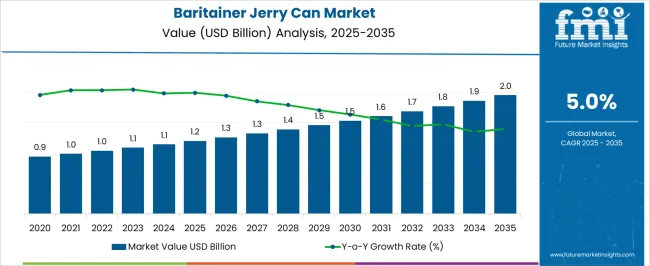
| Metric | Value |
|---|---|
| Baritainer Jerry Can Market Estimated Value in (2025 E) | USD 1.2 billion |
| Baritainer Jerry Can Market Forecast Value in (2035 F) | USD 2.0 billion |
| Forecast CAGR (2025 to 2035) | 5.0% |
The Baritainer Jerry Can market is experiencing steady growth driven by rising demand for durable, lightweight, and food-safe packaging solutions across commercial and industrial sectors. The market is witnessing increased adoption due to the flexibility and ease of handling offered by these containers, which cater to storage and transportation of liquids in both small-scale and large-scale operations. Current trends indicate a growing preference for containers that combine high strength with environmental safety, which supports the shift towards polymer-based packaging solutions.
Investments in efficient packaging infrastructure, coupled with the increasing focus on product safety and hygiene, have accelerated market expansion. The market outlook remains positive as industries continue to prioritize efficient logistics and sustainable material usage.
Innovation in material technology, including recyclable and chemical-resistant polymers, is creating opportunities for product differentiation Additionally, regulatory requirements for food-grade packaging and consumer preference for lightweight and convenient packaging formats are expected to drive continued demand for Baritainer Jerry Cans, particularly in the coming decade.
The baritainer jerry can market is segmented by capacity, material type, end-use, and geographic regions. By capacity, baritainer jerry can market is divided into Up To 5 Liter, 5 Liter To 10 Liter, 10 Liter To 15 Liter, and More Than 20 Liter. In terms of material type, baritainer jerry can market is classified into High Density Polyethylene (HDPE), Polypropylene (PP), and Barrier Additive (Quoral). Based on end-use, baritainer jerry can market is segmented into Food, Flavors, Essential Oils, Edible Oils, Beverages, Chemicals, Automotive, Cosmetics & Personal Care, Household, and Other Industrial Chemicals. Regionally, the baritainer jerry can industry is classified into North America, Latin America, Western Europe, Eastern Europe, Balkan & Baltic Countries, Russia & Belarus, Central Asia, East Asia, South Asia & Pacific, and the Middle East & Africa.
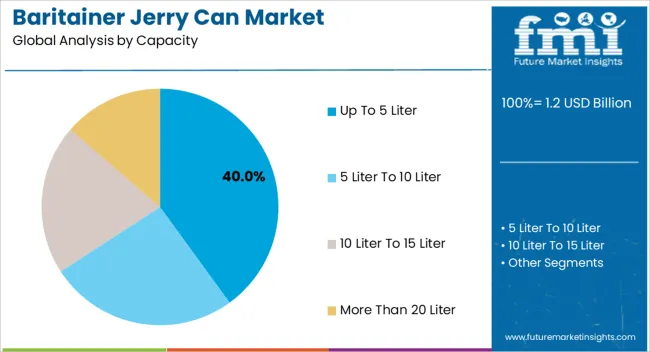
The Up To 5 Liter capacity segment is projected to hold 40.00% of the Baritainer Jerry Can market revenue share in 2025, establishing it as the leading capacity type. The growth of this segment is being attributed to the increasing demand for compact, portable, and easy-to-handle containers suitable for domestic, commercial, and small-scale industrial applications. The convenience of smaller capacities allows users to store and transport liquids with minimal spillage and enhanced control.
Adoption has been accelerated by sectors that require precise portioning, such as food, beverages, and specialty chemical applications. The lightweight nature of smaller cans reduces transportation costs and improves operational efficiency.
Additionally, these containers offer greater compatibility with automated filling lines and are easier to stack and store in constrained spaces, further driving their preference The popularity of this segment is expected to continue due to evolving consumer preferences for convenient packaging and the increasing need for safe and hygienic liquid storage solutions.
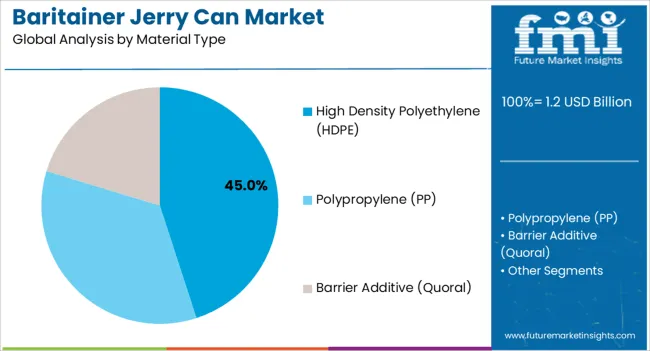
The High Density Polyethylene (HDPE) material type segment is expected to account for 45.00% of the Baritainer Jerry Can market revenue share in 2025, marking it as the leading material type. This growth has been driven by the material’s excellent chemical resistance, durability, and lightweight characteristics, making it suitable for a wide range of applications including food, beverage, and industrial liquids.
The recyclability and cost-effectiveness of HDPE further enhance its adoption in mass production, allowing manufacturers to meet sustainability and economic objectives simultaneously. HDPE-based Jerry Cans provide superior protection against contamination and maintain product integrity during storage and transportation.
The ability of HDPE to withstand temperature variations and rough handling has reinforced its position in the market Increasing awareness of environmental sustainability and the preference for reusable, non-reactive materials are expected to sustain growth in this segment, particularly in industries where product safety and quality are paramount.
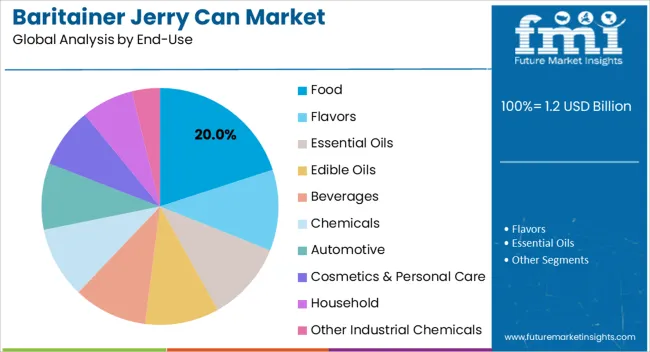
The Food end-use segment is projected to hold 20.00% of the Baritainer Jerry Can market revenue share in 2025, positioning it as the leading end-use application. Growth in this segment is being driven by rising demand for hygienic, safe, and convenient packaging for liquid and semi-liquid food products. Food-grade Baritainer Jerry Cans are preferred due to their ability to maintain product quality while providing ease of storage and transportation.
Adoption is further supported by stringent regulatory standards for food packaging, which emphasize contamination prevention, material safety, and durability. The lightweight and portable design of these containers facilitates handling in both retail and catering environments, enhancing operational efficiency.
The increasing penetration of processed and packaged food products, coupled with the growing focus on supply chain safety, is expected to sustain demand The ability to integrate with automated filling and distribution systems makes this segment highly attractive for manufacturers and end-users seeking reliable, efficient, and hygienic packaging solutions.
Baritainer jerry can is a container made of barrier material and is used to store and package solvents such as household chemicals, industrial chemicals, adhesives, agricultural chemicals etc. along with this baritainer jerry cans are used for safely transit foodstuffs such as flavors, edible and essential oils.
Baritainer jerry cans are manufactured with multiple layers of HDPE mixed with quoral, an additive that utilizes laminate technology. The laminate technology composed of multiple layers of barrier materials in the propylene. Baritainer jerry cans offer various advantages such as cost-effective, impact resistant, lightweight, and are recyclable.
During the construction of baritainer jerry cans, a notch is made at the bottom which makes them easy to stack. Manufacturers of baritainer jerry cans offer baritainer jerry cans in various capacity ranges such as up to 5 liters to more than 20 liters.
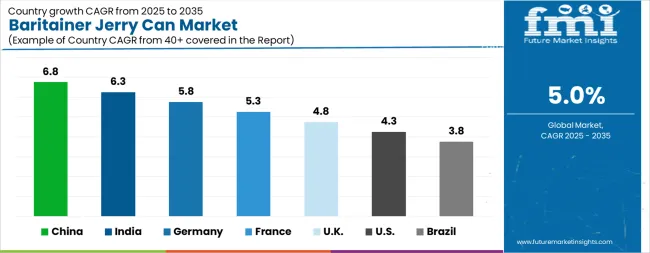
| Country | CAGR |
|---|---|
| China | 6.8% |
| India | 6.3% |
| Germany | 5.8% |
| France | 5.3% |
| UK | 4.8% |
| USA | 4.3% |
| Brazil | 3.8% |
The Baritainer Jerry Can Market is expected to register a CAGR of 5.0% during the forecast period, exhibiting varied country level momentum. China leads with the highest CAGR of 6.8%, followed by India at 6.3%. Developed markets such as Germany, France, and the UK continue to expand steadily, while the USA is likely to grow at consistent rates. Brazil posts the lowest CAGR at 3.8%, yet still underscores a broadly positive trajectory for the global Baritainer Jerry Can Market. In 2024, Germany held a dominant revenue in the Western Europe market and is expected to grow with a CAGR of 5.8%. The USA Baritainer Jerry Can Market is estimated to be valued at USD 435.1 million in 2025 and is anticipated to reach a valuation of USD 659.7 million by 2035. Sales are projected to rise at a CAGR of 4.3% over the forecast period between 2025 and 2035. While Japan and South Korea markets are estimated to be valued at USD 54.6 million and USD 39.3 million respectively in 2025.
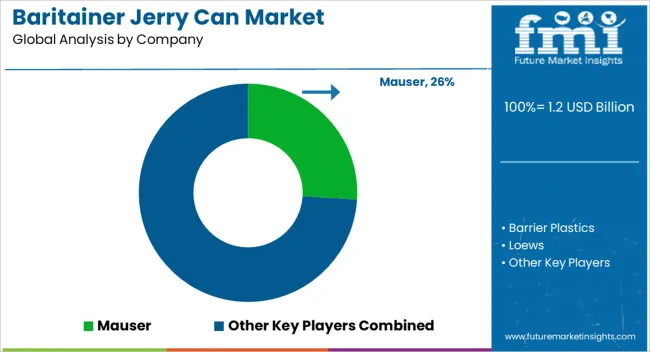
| Item | Value |
|---|---|
| Quantitative Units | USD 1.2 Billion |
| Capacity | Up To 5 Liter, 5 Liter To 10 Liter, 10 Liter To 15 Liter, and More Than 20 Liter |
| Material Type | High Density Polyethylene (HDPE), Polypropylene (PP), and Barrier Additive (Quoral) |
| End-Use | Food, Flavors, Essential Oils, Edible Oils, Beverages, Chemicals, Automotive, Cosmetics & Personal Care, Household, and Other Industrial Chemicals |
| Regions Covered | North America, Europe, Asia-Pacific, Latin America, Middle East & Africa |
| Country Covered | United States, Canada, Germany, France, United Kingdom, China, Japan, India, Brazil, South Africa |
| Key Companies Profiled | Mauser, Barrier Plastics, Loews, Greif, and Menasha |
The global baritainer jerry can market is estimated to be valued at USD 1.2 billion in 2025.
The market size for the baritainer jerry can market is projected to reach USD 2.0 billion by 2035.
The baritainer jerry can market is expected to grow at a 5.0% CAGR between 2025 and 2035.
The key product types in baritainer jerry can market are up to 5 liter, 5 liter to 10 liter, 10 liter to 15 liter and more than 20 liter.
In terms of material type, high density polyethylene (hdpe) segment to command 45.0% share in the baritainer jerry can market in 2025.






Our Research Products

The "Full Research Suite" delivers actionable market intel, deep dives on markets or technologies, so clients act faster, cut risk, and unlock growth.

The Leaderboard benchmarks and ranks top vendors, classifying them as Established Leaders, Leading Challengers, or Disruptors & Challengers.

Locates where complements amplify value and substitutes erode it, forecasting net impact by horizon

We deliver granular, decision-grade intel: market sizing, 5-year forecasts, pricing, adoption, usage, revenue, and operational KPIs—plus competitor tracking, regulation, and value chains—across 60 countries broadly.

Spot the shifts before they hit your P&L. We track inflection points, adoption curves, pricing moves, and ecosystem plays to show where demand is heading, why it is changing, and what to do next across high-growth markets and disruptive tech

Real-time reads of user behavior. We track shifting priorities, perceptions of today’s and next-gen services, and provider experience, then pace how fast tech moves from trial to adoption, blending buyer, consumer, and channel inputs with social signals (#WhySwitch, #UX).

Partner with our analyst team to build a custom report designed around your business priorities. From analysing market trends to assessing competitors or crafting bespoke datasets, we tailor insights to your needs.
Supplier Intelligence
Discovery & Profiling
Capacity & Footprint
Performance & Risk
Compliance & Governance
Commercial Readiness
Who Supplies Whom
Scorecards & Shortlists
Playbooks & Docs
Category Intelligence
Definition & Scope
Demand & Use Cases
Cost Drivers
Market Structure
Supply Chain Map
Trade & Policy
Operating Norms
Deliverables
Buyer Intelligence
Account Basics
Spend & Scope
Procurement Model
Vendor Requirements
Terms & Policies
Entry Strategy
Pain Points & Triggers
Outputs
Pricing Analysis
Benchmarks
Trends
Should-Cost
Indexation
Landed Cost
Commercial Terms
Deliverables
Brand Analysis
Positioning & Value Prop
Share & Presence
Customer Evidence
Go-to-Market
Digital & Reputation
Compliance & Trust
KPIs & Gaps
Outputs
Full Research Suite comprises of:
Market outlook & trends analysis
Interviews & case studies
Strategic recommendations
Vendor profiles & capabilities analysis
5-year forecasts
8 regions and 60+ country-level data splits
Market segment data splits
12 months of continuous data updates
DELIVERED AS:
PDF EXCEL ONLINE
Jerry Cans Market Size and Share Forecast Outlook 2025 to 2035
Industry Share & Competitive Positioning in Jerry Cans
Malaysia Plastic Jerry Can Market Trends & Forecast 2024-2034
Vietnam Plastic Jerry Can Market Analysis – Growth & Forecast 2023-2033
Collapsible Jerry Can Market Growth - Size & Forecast 2024 to 2034
United States Jerry Cans Market Insights – Demand and Growth Forecast 2025 to 2035
Canine Cancer Screening Services Market Size and Share Forecast Outlook 2025 to 2035
Candle Filter Cartridges Market Size and Share Forecast Outlook 2025 to 2035
Can Stack Motors Market Size and Share Forecast Outlook 2025 to 2035
Cancer Registry Software Market Size and Share Forecast Outlook 2025 to 2035
Canine Arthritis Treatment Market Forecast and Outlook 2025 to 2035
Can Stack Stepper Motors Market Forecast and Outlook 2025 to 2035
Canned Wet Cat Food Market Size and Share Forecast Outlook 2025 to 2035
Canned Food Packaging Market Size and Share Forecast Outlook 2025 to 2035
Canada Compact Wheel Loader Industry Analysis Size and Share Forecast Outlook 2025 to 2035
Cancer Biological Therapy Market Size and Share Forecast Outlook 2025 to 2035
Canned Wine Market Size and Share Forecast Outlook 2025 to 2035
Canned Pet Food Market Analysis - Size and Share Forecast Outlook 2025 to 2035
Canada Straws Market Size and Share Forecast Outlook 2025 to 2035
Canthaxanthin Market Size and Share Forecast Outlook 2025 to 2035

Thank you!
You will receive an email from our Business Development Manager. Please be sure to check your SPAM/JUNK folder too.
Chat With
MaRIA